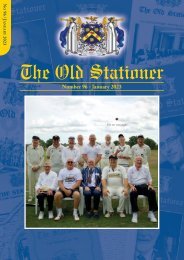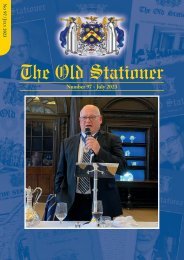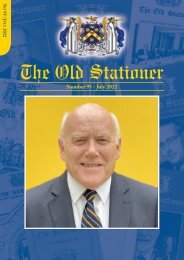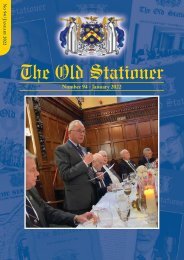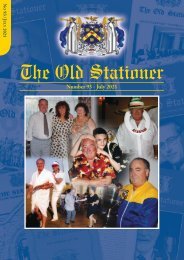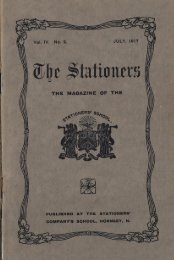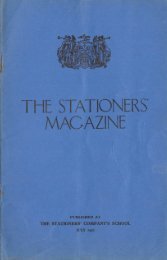OSAmag88
You also want an ePaper? Increase the reach of your titles
YUMPU automatically turns print PDFs into web optimized ePapers that Google loves.
T h e O l d S t a t i o n e r - N o 8 8
months, small viewing areas with park benches would be full of
mothers with prams and children indulging in what might be
termed a picnic. While the mums enjoyed either a nap or
especially a natter, the children would be mostly glued to the
action below on the railway. The clatter and clunk of coal trucks,
beyond the escarpment of allotments, as they were shunted in
Ferme Park Yards by the hoard of various old and dirty J class
0-6-0 steam engines formed a unique resonance to the scene.
For the trainspotters, most of the action would take place near
the heavy wooden gate on Harringay Station footbridge. The
down trains would appear belching smoke which billowed out
from under the bridge over the station platforms. Most of the
older children – around 11 or 12 – would know when the main
expresses were due and thus hope to “cop” the best engines.
Usually armed with a notebook to write down engines' numbers,
these would be underlined later at home in the Ian Allan
Locoshed Book. For the most fortunate this might even be an
Ian Allan ABC British Railway Combined Volume.
An array of steam engines from all sorts of duties were on display
throughout the 1950s and into the 1960s. Later the introduction
of brand new sparkling diesel locomotives somehow ranged less
splendidly. During the early and mid-1950s the only diesels on
view were the ubiquitous 0-6-0 diesel shunters. Gradually their
unique hum replaced the clunky old J class 0-6-0 steam engines
in shunting duties around the yards.
In between these menial engine duties, the pacific class engines
would be rushing express trains to and from King's Cross. They
ranged from the Thompson/Peppercorn A1/A2 classes to the
Gresley A3 and of course the famous A4. The latter was the
undoubted star of the trainspotting show. They lorded express
duties on the line and caused most enthusiasm among the
trainspotters of the day.
Indeed, “Kingfisher has been down” was perhaps the most
exciting news at the time. The Gresley A4 class known to the
initiated as “Streaks” were the favourite main line express engines
to many of the locals and perhaps the crack choice for all the top
link workings. Kingfisher No. 60024 and William Whitelaw No.
60004 rarely ventured so far south to London, their home shed
being Haymarket (64B) on the western side of Edinburgh. Most
trainspotters on the Hog's Back would have “copped” all the
Gresley A4s except for these two particular engines. Thus, they
were popular sights. Whether the pure truth was always told
about the appearances of these rare visitors, one is left to
speculate.
The engines were clearly the stars of any trainspotting show, yet
looking back one also recalls the many named trains, some of
them of the colourfully outstanding Pullman class. The
Elizabethan (previously the Capitals), the Flying Scotsman, the
Heart of Midlothian and the Talisman all travelling to and from
Edinburgh, the Master Cutler to Sheffield, the Cambridge
Buffet, the Yorkshire Pullman, the Queen of Scots (Pullman),
the Aberdonian departing King's Cross at 7:30pm with its
restaurant car at the rear for detachment at Newcastle, the
Northumbrian and the Tees-Tyne Pullman were all examples.
When caught from the front, these trains often appeared in regal
pose sporting a large insignia on the nose of the engine. If not,
they all proudly carried their names emblazoned along the sides
of their carriages above the windows.
While much of the type of traffic was predictable (although the
actual engines were not) occasionally, a complete stranger might
Inner Suburban Service behind Gresley N2 No. 69536 fitted with
condensing apparatus pulling a rake of ubiquitous Gresley (Photo by Ben
Brooksbank). “Quads” articulated stock heading for Hertford North. Note the
”John Bul” on the side of the large building and bearing down on the scene.
be sighted. Perhaps the guest appearance of
4-6-0 County Class No. 1000 County of Middlesex in fully
restored Midland red livery was a memorable if rather strange
sight. Moving into Hornsey shed she made for an antiquated yet
beautiful scene, especially the following day on the front of a
double-headed working, travelling north.
The sleek though smaller V2 or black liveried B1/B12 classes
would front the lesser duties to Grantham, Cleethorpes and in
particular the Cambridge Buffet Express, together with faster
freight workings. The Thompson B1 was easy to spot as it was
the only 'faster' locomotive to be painted in black BR livery,
whereas all the aforementioned classes would usually be sporting
British Railways green.
Outer suburban services to Hitchin, Stevenage or Letchworth
might see a B1 at the front. Inner suburban services however,
would usually be pulled by the stalwart Gresley 0-6-2 N2
complete with the condensing apparatus for working on the
Moorgate service via the Metropolitan lines. Gresley Quad
coach sets were still prevalent. The hand of further development
in BR non-corridor compartment sets often pulled by 2-6-4 BR
standard engines were equally commonplace.
Not quite as glamorous as the main line express engines or even
as neat as the suburban locomotives, the often filthy goods
engines had their own distinctive sound. The austere appearance
of the WD “Dub-Dee” 2-8-0 8F and the sheer potential power
of 9F 2-10-0 were regular visitors to the area bringing in the
heavy coal trains to Ferme Park Yards. Watching these heavy
locomotives shunting across Harringay Viaduct and back into
Hornsey shed could be a specific delight. The distinct clunkclunk
sound of the WD 2-8-0 8F and the array of driving wheels
Goods train coming off Harringay Viaduct while another awaits clearance with
yet a further standing in the shadows of the viaduct. (Photo by Ben Brooksbank)
31



